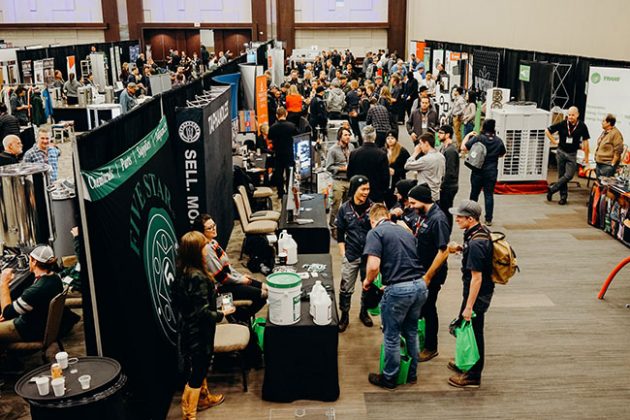
Cultural Links
George Guidoni
General Bottles Bottling Cans LCBO (Liquor Control Board of Ontario) Ontario Craft Brewers (OCB) association Procter & Gamble Inc. The Beer StoreConsumer choice and convenience on top of busy agenda for OCB president
Golf and beer make remarkably good bedfellows for vast numbers of Canadian summer weekend warriors, so it’s more than fitting that Scott Simmons, president of the Ontario Craft Brewers (OCB) association, would have a remarkably close professional affinity to both fields.
Having served for 10 years as chief executive officer of Golf Canada from 2007 to 2017, preceded by a six-year term as vice-president of marketing and business development of The Beer Store beer retail distribution network, Simmons says he is consistently thrilled and honored to be heading a dynamic and buoyant industry group representing one of the province’s fastest-growing industries in any CPG (consumer packaged good) business.
“Like the old saying goes: If you love what you do, you never really work a day in your life,” says Simmons, a graduate of the Ivy Business School at the University of Western Ontario in London, Ont., who began his career with Procter & Gamble Inc., gaining valuable insight into consumer goods business.
That said, the father of four daughters finds himself spending a lot of time on the road crisscrossing the province as the head of OCB to promote products brought to the market by OCB members and other fellow Ontario craft brewers in a concerted effort to maintain the industry’s brisk growth going forward.
Founded in 2003, OCB was formed by 12 craft brewing companies operating in the province at the time to provide a unified voice for the then-fledgling sector that has grown to nearly 300 companies since those early days.
“I’m on the road pretty much every day dealing with the government on the provincial level and, of course, doing a lot of interaction with our members on a daily basis, as well as traveling all over the province to meet with our customers and other third-party industry stakeholders,” says Simmons, who officially took over as OCB’s second-ever president in August of 2017 following retirement of the group’s founding president John Hay.

The Scotiabank Convention Centre in Niagara Falls will be the host venue or this month’s annual OCB Conference and Suppliers Marketplace industry showcase running Oct. 28-30, 2019.
“Interestingly enough, I first met John Hay in 2002 when I was working at The Beer Store,” Simmons told the Canadian Packaging magazine in a recent interview. “Little did I know at the time that I would be heading this association one day, but here I am, more than two years later.”
Says Simmons: “I have a genuine passion for the industry because its people, like myself, really love what they do.
“Their craftsmanship is amazing, bus so is their meticulous attention to quality and the high ethical standards that they put into their practice on a daily basis,” Simmons extols.
“These are small businesses contributing to Ontario’s economy by creating jobs, generating tourism and making positive economic impact.
“A lot of them are located in rural Ontario,” he continues, “where many have become the largest local employers in the small towns—giving back to the communities where they work and live, where kids can have summer jobs in the communities they grew up in, instead of leaving for the ‘Big City.’
“There are so many things to be passionate about with this industry,” Simmons says, “that it really makes going to work fun for me every day.”
For all the fun that goes with the job, however, Simmons is fully aware of the serious burden of responsibility in advancing the industry’s interests among the province’s lawmakers through relentless lobbying and advocacy.
With OCB member-companies accounting for about 95 per cent of the volume of craft beer produced in Ontario annually, Simmons says the Ontario craft beer sector has more than earned the right to enjoy easier access to consumer through opening up more sales channels and the loosening of many legal restrictions still hampering their efforts to reach more Ontario consumers.
“Our government advocacy at Queen’s Park does not stop at the Premier’s Office,” says Simmons, while acknowledging that having a premier like Doug Ford in office is promising for an industry once mired in red tape and heavy-handed government regulations governing beer sales and distribution for the craft sector.
“We also work with the ministries of the environment, tourism and economic development, among others, on many issues affecting the industry,” he relates.
Simmons says he is satisfied that the current Progressive Conservative government is listening to his industry’s concerns, citing several recent lobbying successes that include allowing the craft brewers’ storefront taprooms to stay open for business until midnight, instead of closing at 9 p.m., allowing them to sell beer to the public starting at 9:00 a.m. in the morning, and eliminating the maximum serving requirement of 12 ounces.
However, there is clearly much more to be done to put craft brewers on a more level playing field with the country’s Big Three mass beer producers that jointly co-own The Beer Store distribution network.
According to Simmons, addressing this market accessibility imbalance comes down to allowing craft beer producers to sell their products at more retail locations than the relatively few select supermarkets that the Ontario government designated about two years ago.
“It’s really all about choice and convenience,” Simmons states. “The craft industry has enjoyed tremendous success at the new retail channels so far, with craft beer account for 20 per cent of all beer sales at these locations, compared to 15 per cent at the LCBO (Liquor Control Board of Ontario) outlets and only two per cent at The Beer Store.

“We feel that expanding choice and convenience for Ontario consumers is the right thing to do, whether it is at grocery stores, convenience stores, Big Box stores, specialty alcohol stores, or even letting craft brewers operate their own satellite stores in addition to the ones they operate on-site,” Simmons explains.
“If the provincial government continues with its expansion of the retail opportunities,” Simmons says, “that will allow us to realize the full potential that our industry has in this province.
“You could easily see someone like Muskoka Brewing or Steam Whistle open up a half-dozen or so stores in key Ontario markets,” he argues, “with smaller ones opening up one or two parallel stores in nearby communities.”
As Simmons asserts, the current law allowing microbrewers to sell their products only from locations with an on-site operating brewery are inherently unfair to craft producers, the Ontario consumers and, ultimately, the province’s economy.
“Helping the craft industry in Ontario grow is good for all stakeholders because it would help create more jobs and boost the economic impact even further,” Simmons states.
“We are talking about 300 small businesses, Canadianowned businesses to boot, that could provide more jobs and the tax income the government needs to reinvest in social services, reducing the deficit, upgrading infrastructure and all those other important causes,” Simmons
continues.
“For a government claiming to be supportive of small businesses, supporting this industry falls right into their mandate of growing Ontario’s economy.”
As Simmons notes, Ontario craft brewers are already making a substantial contribution to the provinces economy with a combined 2,500 direct full-time jobs, an estimated 9,000 indirect spin-off jobs elsewhere in the economy, and about a $2-billion annual contribution to the province’s annual GDP (Gross Domestic Product).
But even with such numbers in hand, craft beer sales still account for only a 10-percent share of total $3.5 billion in annual beer sales in the province overall, according to Simmons.
“I truly believe that number can double in the next couple of years with the right retail environment, where craft brewers can operate and compete without handcuffs on,” Simmons says, noting that while the total annual output of Ontario’s entire beer industry has been stalled at about eight million hectoliters for several years, production volumes in the craft beer segment are continuing to grow at double-digit rates.
“These people do such a great job with their products with their high product quality and beautiful packaging, that when you put consumers in an ‘open shopping’ environment where they can shop the entire category, they are clearly choosing craft beer in growing numbers,” he
states.
“There are a lot of consumers who want to support local and homegrown businesses,” he says, “and we want them to have that choice and convenience.”
As part of that, Simmons says OCB wants the government to make retailers open up 30 per cent of their available beer shelf-space to Ontario craft beers, compared to the current 20-percent requirement.
“As it is, most of retailers have already moved beyond 20 per cent because of consumer demand,” he notes, “so we don’t really see that as a major hurdle.
“Some retailers are even creating dedicated sections within craft beer sections to showcase local producers, so that a store in Mississauga will make sure to carry products made in Mississauga or Oakville, for example.
“The growing volumes and market share speak for themselves,” he states. “Not only are these brewers are growing their own share domestically, but some are also venturing into export markets and doing very well there.”

Scott Simmons, President, Ontario Craft Brewers (OCB)
Simmons says he personally enjoys heading a business community as free-spirited and diverse as Ontario’s craft beer sector.
“You’re talking about 300 companies that they come in all different shapes and sizes,” he states.
“There are some that just want to do business in their local communities and sell at their storefront taprooms, while some have a retail footprint right across the province and also into export markets.
“When you total them all together, you get this 15- to 20-percent growth, both domestically and internationally.”
For all that growth, Simmons insists the Ontario market is nowhere near the saturation point yet.
“We need to continue to grow the industry so that it can double or more in the next few years,” he proclaims.
“In British Columbia the market share for craft segment is already at 20 per cent,” he points out, “and there are many U.S. states where crafts account for 25 per cent.
“A lot of that has to do with the more open local retail environment for craft producers, and that is exactly what OCB is aiming to achieve for our members and other craft brewers who we hope will become our members when they’re ready.
“Many of these brewers have only been around for two or three years, so in many ways we are trying to catch up,” he says.
“But while we are constantly trying to grow our membership, we also have very high standards a brewer must meet to become an OCB member.
“But at the end of the day,” Simmons sums up,“there is no question that we are all stronger as a collective unit than individually.”
Advertisement

